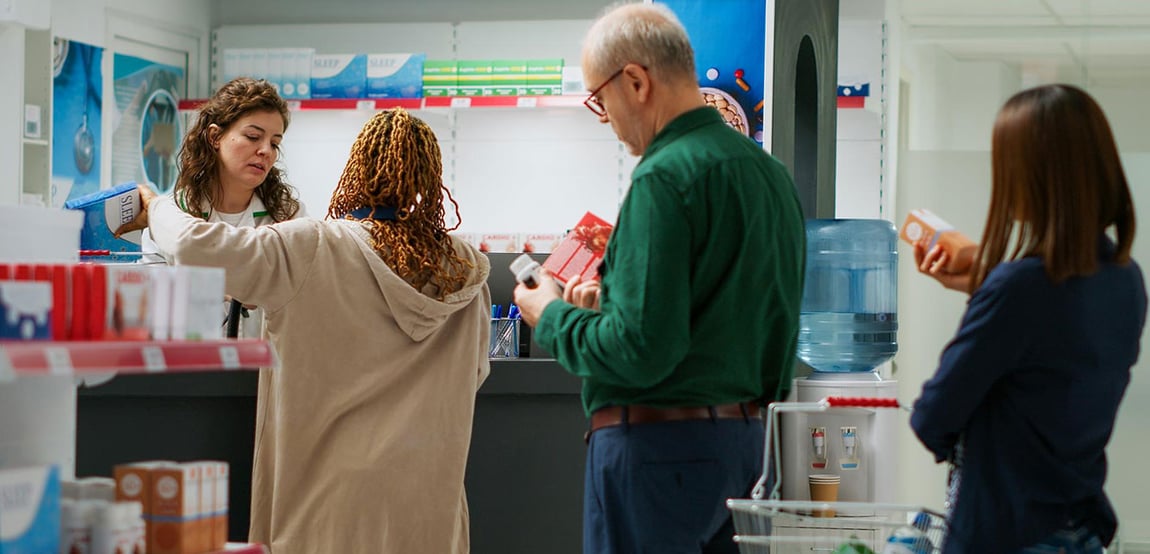By reducing the possibility of human errors in medication dispensing, dosages, and quantities, companies ensure patient safety, well-being, and legal compliance.
Medication dispensing is the process by which medications are provided to patients according to medical prescriptions, where the process involves the safe and accurate dispensing to patients by the medication delivery point, pharmacy, hospital, or other healthcare setting.
Medication dispensing typically involves 5 key steps:
- 🧾 Receipt of the medical prescription: The process begins when a physician issues a medical prescription for a patient. This prescription or formula can be physically delivered by the patient or sent electronically from the medical office.
- ✅ Formula verification: At the pharmacy, a pharmacist or pharmacy technician verifies the authenticity of the prescription and reviews the information to ensure it is complete and legible.
- 💊 Medication preparation: Once the prescription is verified, the medication is prepared according to the doctor's instructions. This may involve counting pills, preparing liquids, or performing other forms of pharmaceutical preparation.
- 🏷️ Medication labeling: The prepared medication is labeled with relevant information such as the patient's name, dosage, administration instructions, and any other information required by law.
- 🫴 Delivery to the patient: Finally, the prepared and labeled medication is handed over, along with any additional information regarding its use and potential side effects.

This is where accuracy and safety in dispensing ensure the well-being of patients, but where errors can have serious consequences. Therefore, the process adheres to strict standards of quality control and safety at all stages. In some cases, governmental entities regulate service times and quality. In the case of Colombia, for example, it is imperative that companies providing medication delivery services comply with the regulations set by the Superintendencia Nacional de Salud regarding delivery times, service quality, accuracy, and precision.
From Concept to Reality: a Case Study
Efficiency and Precision: Automation in 'Medication Dispensing' with SAP BTP
Our client, a non-profit private corporation operating within the Family Subsidy System and the Colombian Social Protection and Security System, offering a range of social services including healthcare, as well as others such as education, food, and beverages, faced several challenges to improve the medication dispensing process and ensure legal compliance:
- Enhance delivery times to meet the requirements set by the National Health Superintendent.
- Ensure proper dispensing practices to guarantee the correct medication, in the prescribed concentration, and in the indicated quantities.
- Improve the quality of dispensing service to patients.
- Prevent overdosing and related fraud.
- Optimize inventory management in pharmacy centers.
- Provide quick and timely attention, with a maximum time of 10 minutes per patient.
- Address the high daily volume of medication dispensing.
Tackling a Crucial Challenge: Overdosing in Medication Dispensing
Overdosing occurs when a patient receives a quantity of medication exceeding that prescribed by the doctor or recommended by the manufacturer. This situation can arise due to various reasons, including human errors, issues in the dispensing process, or lack of communication between the doctor, pharmacist, and patient. It can have serious consequences for the patient's health, including adverse side effects.
Some common causes of overdosing in dispensing include:
- Calculation errors:
Human errors in medication preparation can lead to an incorrect dosage. This can happen during the measurement of the correct amount of medication or when calculating the appropriate dosage for the patient.
- Misunderstandings:
Lack of communication between the doctor, pharmacist, and patient can result in an incorrect dosage. This can occur if the doctor does not clearly specify the dosage in the medical prescription and the pharmacist misinterprets the prescription or if the patient does not understand the dosage instructions.
- Labeling issues:
Errors in medication labeling can lead to incorrect dosing. For example, if the medication is mislabeled or if the label does not clearly indicate the correct dosage, the patient may take an incorrect amount of the medication.
Therefore, it is essential for healthcare professionals, including doctors and pharmacists, to take steps to prevent overdosing in medication dispensing by ensuring clear and effective communication among all parties involved. Careful verification of medical formulas and dosages is achieved through the implementation of an automated dispensing system accompanied by safety protocols to help reduce the risk.

The Evolution of Medication Dispensing:
From Manual to Automated Vision Leveraged by Technology
Transitioning from manual to automated dispensing offers a range of significant benefits for both patients and healthcare professionals, pharmaceutical organizations, and medication delivery points, where the transition is undoubtedly advantageous.
To address the challenges of our client, we implemented the SAP BTP solution, which generated significant value in terms of time and cost savings, leveraging the entire dispensing process in a cloud system with high availability 24/7. This simplified management, operation, and execution with precision and efficiency.
.png?width=870&height=199&name=CO%20-%20Infograf%C3%ADas%20(1).png)
Today, more than 120,000 prescriptions are dispensed daily to over 4 million patients within the time frame established by the Superintendencia Nacional de Salud.

Exploring 6 Benefits Redefining the Patient Experience
Improving healthcare safety and efficiency isn't the only goal pursued by companies providing medication dispensing services; they also aim for cost reduction, improved inventory management, and increased access to healthcare. Consequently, they pursue additional key benefits for the business:
- 🛡️ Precision and Safety:
Automated systems can significantly reduce the risk of human errors in medication dispensing, such as incorrect doses or wrong medications. This enhances patient safety and reduces the chances of errors that could result in serious health consequences.
- 🎯 Efficiency:
Automation allows for faster and more efficient medication dispensing, saving time for both healthcare professionals and patients. Automated systems can process orders and prepare medications more quickly than manual methods, improving overall productivity and efficiency in the healthcare system.
- 📝 Inventory Management:
Automated systems can assist in inventory management by automatically tracking stock levels and medication expiration dates. This facilitates timely stock replenishment and reduces medication waste due to expiration.
- 💸 Cost Reduction:
Although the initial investment in automated systems may be considerable, in the long run, it can generate significant savings by reducing costs associated with dispensing errors, excess inventory, and time spent on repetitive manual tasks.
- 🩺 Improved access to healthcare:
Automation can help overcome geographical and access barriers by enabling dispensing in areas where healthcare is limited. Automated systems can be installed in remote locations or in automated pharmacies operating 24 hours a day, providing convenient access to medications even outside of regular business hours.
- ✅ Medication Adherence:
Some automated systems are designed to remind patients when to take their medications and provide exact doses, which can improve medication adherence and ultimately health outcomes.
This is how automation also helps redefine the patient experience by offering greater convenience, safety, expanded access to medications, personalized education, and follow-up, which undoubtedly leads to a significant improvement in how they interact with their medical treatment. It provides a smoother and seamless experience from the moment the medical prescription is presented until the necessary medications are acquired.
By optimizing wait times and the ability to access medications safely and efficiently through automation, it is possible to ensure precise dosing, minimizing the risk of errors that could jeopardize patient health. This offers peace of mind for both patients and healthcare professionals, knowing that rigorous protocols are being followed for their safety. This redefines the patient experience, making it safer, more convenient, and patient-centered.
Finally, it is worth noting that automating medication dispensing not only improves operational efficiency and patient safety but can also have a positive impact on sustainability by reducing medication waste, optimizing resource use, and minimizing the environmental footprint of the pharmaceutical industry. By improving operational efficiency and reducing resource waste that impacts carbon footprint, we contribute to mitigating climate change and the global effort to reduce greenhouse gas emissions.
Transform with Avvale
At Avvale, we are open to starting this conversation to support efficiency and precision in automating 'Medication Dispensing' with solutions like SAP BTP that help generate optimal response times, business productivity, and improve patient service quality. By automating, we are also helping companies reduce paper usage and save energy resources, all in support of sustainability.
Are you ready to lead your company towards an agile, circular, and sustainable future that optimizes medication dispensing supported by innovation and technology?





.png?width=870&height=199&name=CO%20-%20Infograf%C3%ADas%20(1).png)


